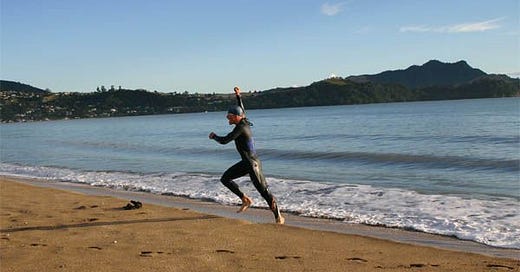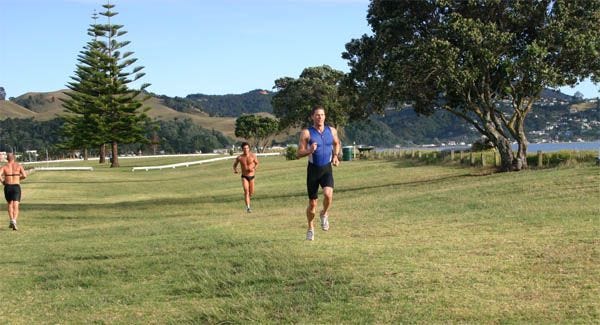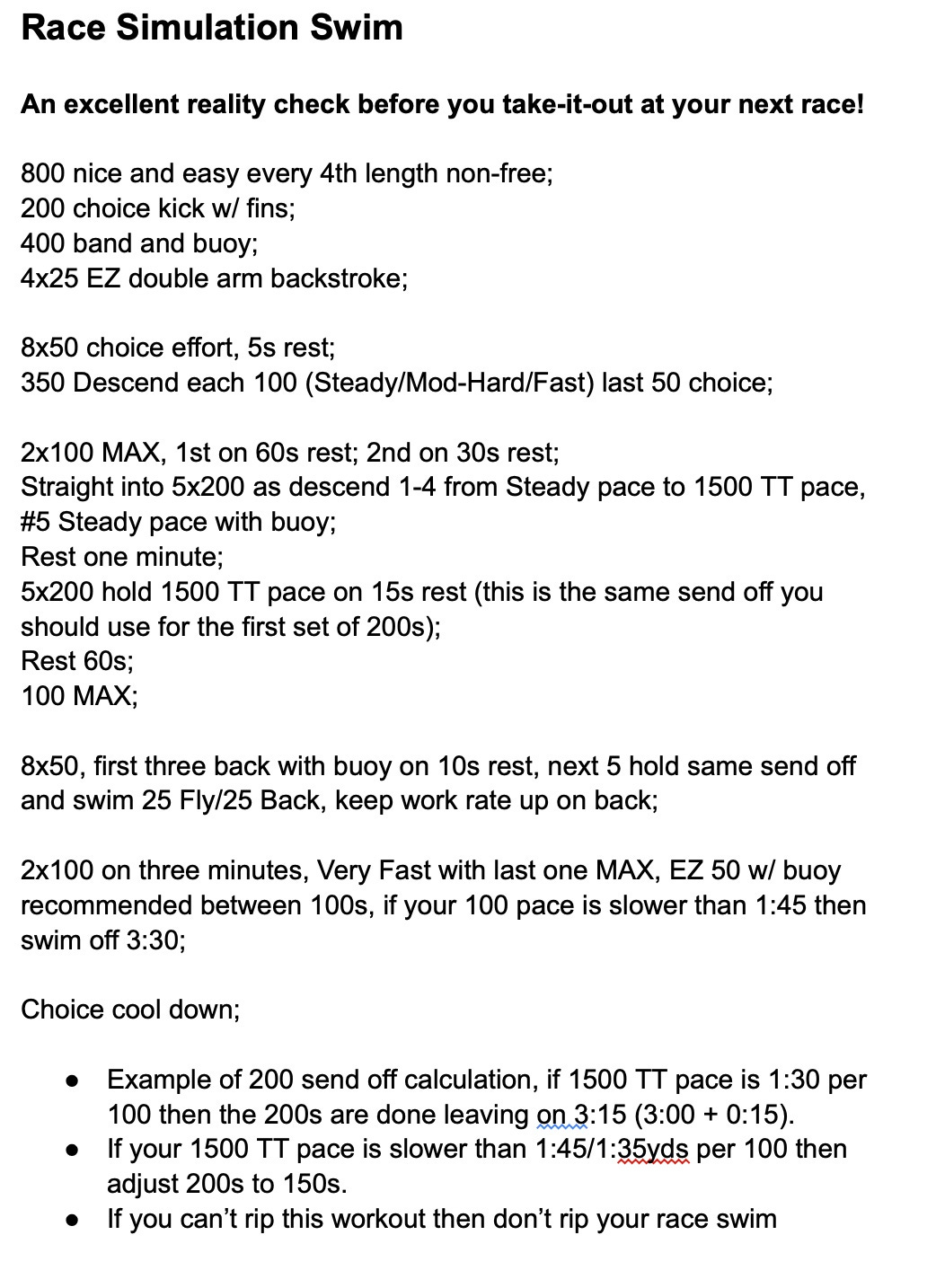Combination workouts are useful for more than time management.
They challenge an athlete to use:
Different Muscle Firing Patterns
Different Muscle Groups
Different Skill Sets
You may be doing combination workouts already and not realizing it:
Medley Swimming (Fly, Back, Breast, Free)
Flip Turns, Medley Turns & Breakouts
Changing Bike Position (Standing, Sitting)
Changing From TT Position (Flats) to Seated/Standing When Climbing
Run:Walk
The ability to efficiently change between, and within, modes of exercise brings benefits to the athlete:
Improved Athleticism
Whole Body Metabolic Fitness
It is also an essential component of fast Multisport racing.
Bricks (From Building Your Long Run)
The classic triathlon combination is called a Brick: Bike then Run.
Brick Warm-Up: Runners seeking to improve their metabolic fitness can warm-up on the bike (Easy pace, quick cadence) and create a longer duration workout. This is a simple way to build total workout duration, while keeping run volume the same.
Multiple Bricks: Marathoners seeking to train their race duration can mix multiple transitions into a combination workout.
For example: 2 or 3 rounds of 30 minutes Bike / 30 minutes Run
Progressive Brick: Using the bike to simulate late race feeling, with lower biomechanical risk.
The pattern is:
40 minutes Bike / 20 minutes Run
30 minutes Bike / 30 minutes Run
20 minutes Bike / 40 minutes Run
The last 40-minute run will give the runner a taste of late workout fatigue and also give them the confidence to “take it easy” early in the race. The same pace feels very different after 2.5 hours of exercise.
Real Talk About Your Swim Pacing
Ask a novice triathlete about the combination they most notice, and they will talk about their Bricks (bike-run workouts). While this transition is important, there’s another transition that’s often costing more performance.
As I shared inside my article on Visualization, improper swim pacing is a source of underperformance. From that article…
My underperformance would continue from the swim, well into my bike leg.
Digestive Problems
Elevated Heart Rate to Power
Difficulty With Uptake Rates
Abdominal Cramping
Breathlessness
Triathletes, and every other athlete with digestive issues, early pacing is likely the cause of your problems.
Combination workouts help athletes train to tolerate intensity as well as the stress associated with transitioning between muscle groups.
Intensity
Muscle Group Transitions
These are two different things, and worth thinking through.
Am I Clueless With Pacing?1
Are My Muscles Not Used To Transitioning?
Yes and Yes.
Let’s give you some help.
Swim Combinations
So, you want to take it out (!) on the swim and sprint through first transition…
Let’s test that hypothesis.
Burpee Swim: Do your typical race warm-up then… 5x300 with 10 burpees (on the deck) between each interval. Swim continuous, without additional rest.
Pace your 300s as…
Fast
Moderate
Fast
Moderate
Fast
There’s no right, or wrong, answers here. After the set consider if you’re well positioned to ride well and run very well.
With this workout, and all the others, don’t base your assessment on what happens the first time you try the session.
Your brain needs to learn “fast” relative to your race duration.
Your body needs to learn how to transition between modes.
Poolside Swim-Bikes: Bring an indoor trainer poolside (or nearby).2
Warm-Up With An Easy 1000 mixer
Main Set:
300 to 400 meter swim followed by 4 to 6 minutes bike
Repeat 3 to 4 times
Descend For Effort By Combination
Steady / Zone 2
Moderately-Hard / Zone 3
Hard / Zone 4
Very Hard / Zone 4+
Choice Cool Down Swim or Bike
John Hellemans notes:
Adjust the distance and intensity to fitness level, experience and your event.
With elites we might make it more specific, e.g. do the first 50 meters of the swim as a sprint, before backing off in a prescribed lower zone, and on the bike they might vary the intensity during the 6 minutes by inserting Sprints…. to mimic the pace variations in draft-legal racing.
Do the first 400 meter swim in a wetsuit and work on quick transitions.
Recovery between sets 1 to 2 minutes.
Poolside Aquathons: Another Kiwi Special, best done long course (50 meter pool)
Course Prep
Open The Fire Escape3 and place a cone 100 to 250 meters away
Float A Buoy Under The Far Side Flags - this is your turnaround point
Set The “Swim Course” 2-3 Lanes Wide
Mass Start Under The Flags
Similar idea to John’s Swim-Bike Reps. Create different swim-run events.
Run-Swim-Run
Swim-Run-Swim-Run-Swim
Swim-Run-Swim
These usually turn out to be high-intensity sessions, so factor them into your Red Zone allocation for the week.
These workouts provide a quick education for open water swimming:
Pace Changes
Crowded Starts & Turns
Holding Pace Around Turns
Fast Transitions
Long Course Triathletes
See what happens to your endurance cycling after a tough swim.
Start by setting the bike up poolside or prepare for a quick swim-to-bike transition on the road.
After your swim workout, quickly transition to your bike and hold Steady watts/effort. See how much your heart rate decouples and how long it takes to re-couple. If you don’t have access to a powermeter then use a standard course and compare HR vs Time.
This type of workout helps you optimize your swim pacing strategy. Non-drafting agegroup triathletes will discover extra effort is best saved for the run.
More information in my article Benchmarking Your Swim.
A Training Triathlon
A favorite Kiwi session. I’ll let John describe…
Combination workouts are particular to triathlon. Generally, we don’t do enough of them.
The Saturday morning Corsiar Bay workout, remains a part of the staple training diet for many Cantabrian triathletes.
Bike over the hill from Christchurch to Corsiar Bay in Lyttleton Harbour (approx. 1 hr), Swim 30 to 60 minutes around the boats moored in the bay, followed about a run around the hills of Lyttleton (45-90 min), then bike back home.
Depending on the distance you train for, you can vary the swim and run time.
Some athletes take their car to Corsiar Bay and do a swim-bike-run from there, which is even more specific.
Your speedy Kiwi competition is doing Bike-Swim-Run-Bike, weekly. Highly effective, fun and excellent time management.
Don’t have access to open water? No problem.
Bike, or run, the the pool. Bike or run home.
Alternatively, load the car up, drive to the pool, bike after your swim and add an easy transition run.
Bike-Run Hill Reps
This session was developed by John Hellemans when he was working with Erin Baker. It went right by my house on Mt Pleasant Road in Christchurch, New Zealand.
I like this session because “the hill does the work.” It's an effective way to build sport specific strength and will complement big gear work, in an athlete’s program.
From My Combination Workouts Document.
Course:
A cycling hill 10-20 minutes long
Transition area - safe place to leave shoes/bikes
A gradual uphill run route 800 to 2000 meters
Protocol:
Rep duration is bike favored: 20/10, 20/5, 18/6, 15/5, 12/6
Probably depends on your course
Total main set duration is 45-90 minutes
Three cycles is enough
First - just do it
Second - Moderately-Hard - Zone 3
Third - little bit faster
This a tempo workout (Mod-hard/Hard - Zones 3 to 4)
Stay under Critical Power/Functional Threshold/Lactate Threshold 2
Aim for total work of 45-90 minutes
Workload should not impair “tomorrow”
Stop knowing you could go “even faster” for a 4th cycle
Remember you need to jog back down to the bike transition area - so your uphill run length can be ~4 minutes to yield 10 min running per lap.
Next Time, we’re going to:
Dig deeper into BikeRun reps.
Explain how to progress/insert into your plan.
Offer guidance based on your ability level & goal event distance.
Back To Table of Contents
Pace fade is obvious if you track velocity vs effort during your endurance sessions. Too many masters swimmer find themselves “gasping & fading” at every workout. Be strong at the end.
This session is a staple of the Kiwi Olympians I trained alongside.
Before staging your aquathon, obtain permission from pool management.









